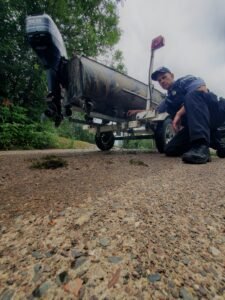Rural Marathon County Call Puts AED Into Action
An article from WWA’s Words From The Wardens.
This article originally appeared in Wisconsin Waterfowl Association’s December, 2024 eNewsletter.
By DNR Conservation Warden Kyle Ziembo
When I received an automated external defibrillator (AED) for my Wisconsin Department of Natural Resources (DNR) conservation warden truck, I did not expect to use it, as my service territory in Marathon County is fortunate to have full-time emergency medical response teams.
My warden teammates and the other DNR wardens statewide completed the training to use these life-saving devices when a person’s heart stops. As we all know, a fast response is critical for the person suffering cardiac arrest.
When I found a place to store it in my truck in mid-April, I assumed it would likely become a fixture that might turn into a shelf.
I was wrong. Two weeks later, in early May, I was on patrol at a Marathon County boat landing with my supervisor, Lt. Bryan Lockman. That’s when we heard the radio transmission of a man experiencing suspected cardiac arrest.
We knew we were about 10 minutes from the emergency call location and likely the closest law enforcement unit. We pointed our truck south and immediately headed for the address.
When we arrived, the man’s wife, a trained nurse, was performing CPR to revive him. We got our AED and raced to the man’s side as he was down in the yard. He had no pulse and was not breathing. We attached the AED and followed the instructions on when to apply a shock to the heart and when to continue the CPR.
It was about 20 minutes since the man’s collapse when the emergency medical service team arrived and took over the treatment. A pulse was felt as he drifted into consciousness and was placed in the ambulance.
The story’s purpose is not to cast us as heroes but to detail how all the wardens have AEDs in their trucks, another public service we can perform if an emergency arrives.
Marathon County is a gorgeous county with vibrant urban areas. However, it also has some remote, rural areas where your conservation wardens may be able to help if a person’s life is on the line.
The Wisconsin conservation wardens are all about public service and helping where we can and in the best way possible.
I’d like to finish my column with a quote from my Deputy Chief Matt O’Brien.
“This statewide AED deployment is about extending the public safety umbrella into some of Wisconsin’s most remote areas, including our forests, lakes, marshes, wilderness areas and recreation trails. By having adequately equipped and trained responders across Wisconsin’s landscape, the warden service is helping to supplement local resources by delivering time-sensitive defibrillation throughout the state’s landscape.
“Wisconsin’s conservation wardens are dedicated to providing safety and emergency assistance to citizens and visitors as they recreate; this AED deployment improves the likelihood of positive outcomes, regardless of where a dangerous cardiac event strikes.”
















